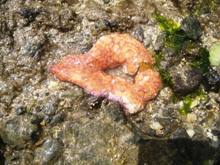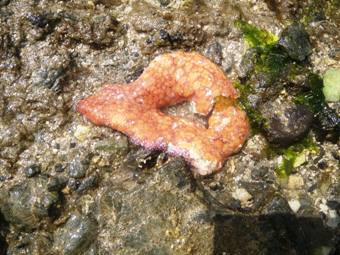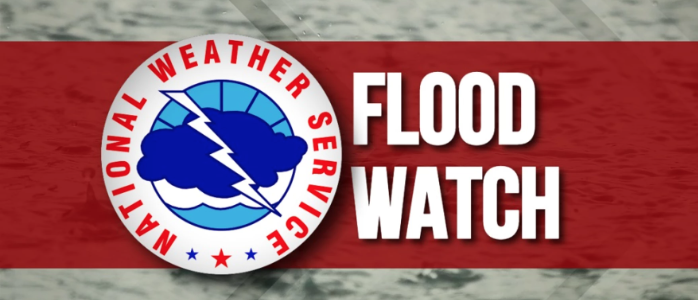— by Russel Barsh —
On Sunday June 29, I examined 658 Ochre Stars at Indian Island. Seven percent of the Ochre Stars I examined were unmistakably diseased. This is significantly greater than the 1-2 percent incidence we observed consistently over the previous five months, but far less than other researchers have suggested. Some increase in infection rates is consistent with the warmer weather of midsummer. The total number of seastars on the beach has not decreased, nonetheless.
Interestingly, the incidence of Seastar Wasting Syndrome was more than twice as high on the west side of the island, where most visitors tend to walk along the beach, than on the rockier and less walkable east side. A connection is possible. Pathogens can be carried on human hands, boots and sandals. However, the two sides of the island differ in other ways as well. The west side has stronger currents, for example, and more seaweeds.
We also observed seagulls eating some of the diseased animals. Pathogens such as bacteria, viruses and fungi rarely “jump” to other kinds of animals, so it is unlikely that the seagulls will be sickened. But it is possible that seagulls either help reduce contagion by removing sick seastars from the beach — or that they help spread the pathogen through their faeces.
Thus far, our observations have been limited to the inter-tidal zone, which is a very small portion of Ochre Stars’ habitat. Sub-tidal surveys would be very useful. There is also a question whether diseased seastars are more likely to be seen in shallower water, for example because they have lost some mobility, or simply get washed up. If so, estimates of disease rates from inter-tidal counts would be biased upwards.
The Indian Island Marine Health Observatory team will survey seastars again in mid-July, late July, and August.
**If you are reading theOrcasonian for free, thank your fellow islanders. If you would like to support theOrcasonian CLICK HERE to set your modestly-priced, voluntary subscription. Otherwise, no worries; we’re happy to share with you.**







